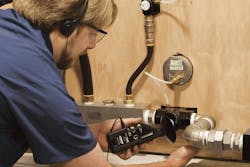The Old Timer of Royal Oak, Mich., was a regular contributor to H&P years before we ever even heard of the internet. But most of his advice is just as ueful — and interesting — today.
So rather than leave his wisdom printed on pages archived in our storage room, I pulled out issues from the late 1980s and early 1990s and have been reproducing relevant entries in this blog. Here is my twelfth entry, which was originally published in the December 1988 issue:
Sometimes, instruments can be too sensitive
Our Experimental Division sometimes got prototypes of monster machines before they were put into production. One such machine had five big accumulators on it requiring precharge pressures ranging from 500 to 1750 psi. To provide the precharge, we connected eight nitrogen cylinders to a common header then raised the pressure with a portable five-stage air compressor to the levels needed in the accumulators.
This equipment included an omni-directional microphone with earphones and a large meter. We’d point the mic around the room, and any gas leaks would be translated into sound in the earphones and needle movement on the meter.
I was inspecting the setup with the leak detector one quiet morning when the meter suddenly pegged full over, then returned to normal. Looking for this sudden leak, I kept wandering around the machine and waving the microphone. After several trips I narrowed the sound down to the northwest corner, where a pipefitter was making some minor assemblies. It took another half-hour to finally zero in on the cause of this erratic short-duration gas-leakage signal.
It was the pipefitter! He was a great lover of chili and had indulged in his passion the previous night. The resulting intestinal gas was quietly squeaking out and driving our instrument meter off the scale.
You can imagine the tact it took to explain to my boss that I had spent most of the morning tracking down a chili lover.


